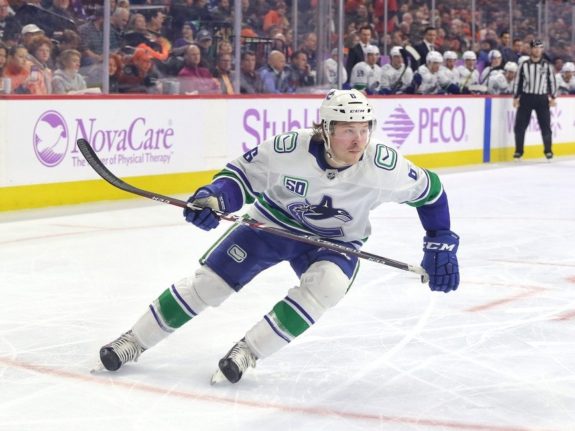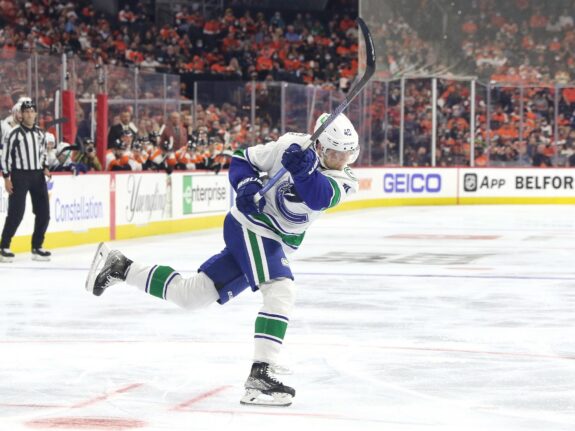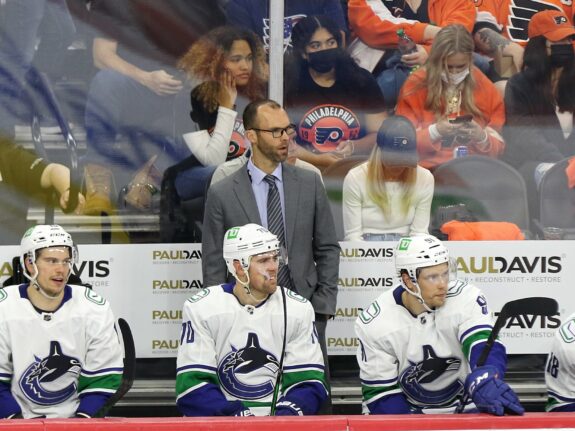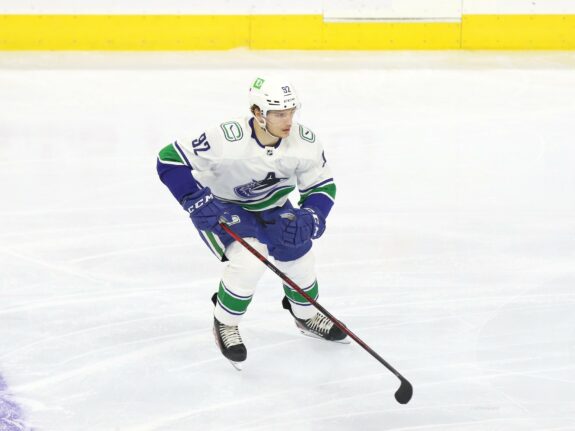On paper, the Vancouver Canucks should have the personnel to roll out two very lethal power play units. Unfortunately, the game is not played on paper. If it was, they would be in the same realm as the Edmonton Oilers. With players like Elias Pettersson, Brock Boeser, Bo Horvat, and Quinn Hughes on the roster there should be no excuses for having a bad power play. Except, early in the season, that’s exactly what they have and it has cost them points in the standings. Last season, the coaching of Newell Brown was to blame. Now that excuse is gone, as Jason King has taken over those duties.
Related: Canucks Daily Download
Correct me if I’m wrong, but I have not seen many changes to the power play and its tactics since he took over. It still utilizes the drop pass, it’s still too reliant on the Horvat bumper play, and for the most part, it doesn’t move the puck nearly as quick to open up seams in the opposition’s penalty kill. Fortunately, the Canucks have the players to turn it around. All they need is a few tweaks to get it going in the right direction.
Run the Power Play Through Boeser and Pettersson’s One-Timers
The Canucks have two potent one-timers on the power play in Boeser and Pettersson. Yet, they rarely use both of them. With Boeser as a right-hand shot and Pettersson as a left-hand shot, they are prime candidates for easy one-timers from both sides of the ice. Add the dynamic playmaking of Hughes up top and you have the recipe for a very dangerous power play that should be difficult to contain.


With the threats of one-timers from both sides, the opposing team’s penalty killers will have to spread their coverage out. Right now, they’re covering Horvat’s bumper play too closely and cheating over to Pettersson’s side to neutralize his one-timer. Basically, what I’m saying is, they should use both of their weapons instead of just one.
Use Podkolzin on the Power Play as a Net-Front Presence
Through four games, Vasily Podkolzin has only three seconds of power play time and Justin Dowling has 5:57. That needs to change. The second unit has arguably been better at generating shots and chances, but that doesn’t negate the fact that the Canucks are holstering a big weapon in their power play arsenal.
Related: Canucks Additions Should Make the Power Play Lethal in 2021-22
Podkolzin has proven in the past to be a very effective player in front of the net. He’s also a great playmaker from the goal line and possesses the size, strength, and hand-eye coordination to be as good as Ryan Kesler was back in 2010-11 when he scored 15 goals on the power play. During the World Juniors and the KHL Playoffs, Podkolzin showed he can be a major factor with the man advantage. If they don’t start using him on at least the second unit power play, they are wasting his talent. I guarantee you he will generate more than Dowling has to this point.
Quicker Puck Movement and Stop Using the Drop Pass Already
Even without Brown running the power play, the drop pass is still being used. Yes, the Oilers use it with the speedy Connor McDavid, but the Canucks do not have that type of supreme talent on their roster. What they do have is Hughes and Pettersson, two players who have tremendous puck handling skills and hockey IQ. Instead of using the drop pass, just let one of them take control and lead the five-man unit into the offensive zone with speed. Use all five guys instead of just one.

Once the Canucks are in the zone, they need to start moving the puck a whole lot quicker too. Through the first four games, the power play has looked stagnant and easy to defend. With quicker puck and player movement, the opposition’s penalty kill will have to move, thus opening up passing and shooting lanes for the elite playmaking and one-timers of Pettersson, Hughes, and Boeser.
Mix It Up With New Power Play Units
First Unit
| Brock Boeser | J.T. Miller | Elias Pettersson |
| Vasily Podkolzin | Quinn Hughes |

Speaking of Podkolzin on the power play, this unit has him as the net-front presence and J.T. Miller as the bumper over Horvat. With the threats of one-timers from both sides, the playmaking and size of Miller and Podkolzin, and the dynamic quarterbacking from Hughes, this power play should be a threat to score every time they’re on the ice. As long as they move the puck quicker and stop using the drop pass, that is.
Second Unit
| Conor Garland | Bo Horvat | Nils Hoglander |
| Jack Rathbone | Oliver Ekman-Larsson |
As you can see, there are no mentions of Dowling or Tanner Pearson on this unit. Now that Horvat has dropped from the first unit to the second, they don’t need the services of Dowling as a faceoff man. By using Horvat here, the Canucks spread the wealth to create two potentially lethal power play groups. Ekman-Larsson and Jack Rathbone man the points on an old-school two defence formation and Garland and Hoglander complete the ensemble with their work ethic and dogged puck pursuit skills. If used correctly, this unit could be just as dangerous as the first.
Canucks Power Play Needs to Be a Positive Difference-Maker
As of this writing, the Canucks power play ranks 17th in the league at 20 percent. They have only scored three power play goals and two of them came in the same game. Overall, they have gone 0/7 since their last goal against the Philadelphia Flyers and they haven’t looked overly good in any of them since then.
For the Canucks to turn it around and move this season in the right direction, the power play has to start scoring more consistently. If nothing else, it has to at least start scoring timely goals. When they get a power play with the game on the line, whether it be while trailing or not, it can’t be a non-factor. Now, I know it’s way too early to be hitting the panic button, but if they don’t turn their power play around at some point this season, it will be one of the reasons they miss the playoffs in April.
